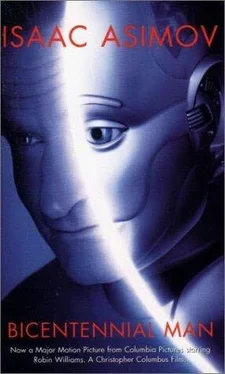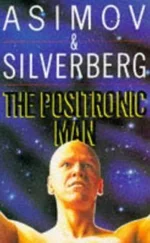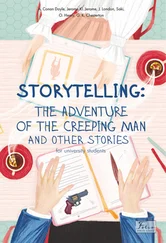“What if the President is human?”
“I’ll leave that to you. You will know.”
Janek said, “I am not that confident of myself. What if I can’t decide? If I can’t bring myself to? If I don’t dare to? What are your plans?”
Edwards looked tired. “I don’t know. I may have to go to U. S. Robots. But I don’t think it will come to that. I’m quite confident that now that I’ve laid the problem in your lap, you won’t rest till it’s settled. Do you want to be ruled by a robot?”
He stood up, and Janek let him go. They did not shake hands.
Janek sat there in the gathering twilight in deep shock. A robot!
The man had walked in and had argued, in perfectly rational manner, that the President of the United States was a robot.
It should have been easy to fight that off. Yet though Janek had tried every argument he could think of, they had all been useless, and the man had not been shaken in the least.
A robot as President! Edwards had been certain of it, and he would stay certain of it. And if Janek insisted that the President was human, Edwards would go to U. S. Robots. He wouldn’t rest.
Janek frowned as he thought of the twenty-seven months since the Tercentenary and of how well all had gone in the face of the probabilities. And now?
He remained lost in somber thought.
He still had the disintegrator but surely it would not be necessary to use it on a human being, the nature of whose body was not in question. A silent laser stroke in some lonely spot would do.
It had been hard to maneuver the President into the earlier job, but in this present case, it wouldn’t even have to know.
***
My first thought was to call the previous story “Death at the Tricentennial,” but the dictionary assured me that “tercentenary” was a perfectly good way of referring to a three hundredth birthday, so I called it “Death at the Tercentenary.”
Fred changed that name to THE TERCENTENARY INCIDENT, which was a great improvement in my opinion, and I adopted it with glad cries. I am not always pleased with his title changes and generally say so, as in my collection of mystery short stories Tales of the Black Widowers. It is only fair now that I give him credit for a good change.
—One more thing. Again, this story represents a return to a theme I handled in an earlier story.The earlier story in this case was EVIDENCE, first published in 1946, thirty years before this story was. There is, except for theme, no similarity between the two stories, and I leave it to the Gentle Reader, if he or she has read both, to decide whether I have improved or not in the interval. (Don’t write, however, unless you think I have improved.)
Time flies. I myself am ever-youthful, but everything else is getting older. Do you realize that with the April 1976 issue, Amazing Stories, the oldest of the science fiction magazines, celebrated its Semicentennial?
The April 1926 issue of Amazing Stories was Volume I, Number 1. It was the very first issue of the first magazine ever to be devoted entirely to science fiction—and that was fifty years ago.
Hugo Gernsback had been born in Luxemburg in 1884 and had emigrated to the United States in 1904. He went on to write some excruciatingly bad science fiction with some excruciatingly good predictions in it, to edit a magazine, in which he included science fiction stories (or scientifiction, as he called it), and to begin thinking of publishing an all-science-fiction magazine for some time. A probing circular be sent out in 1924 brought in disappointing results, but then, in 1926, without any advance fanfare at all, he placed the new magazine on the stands.
Sol Cohen, the current publisher of the magazine, called me in the fall of 1975 to ask me if I could make some contribution in honor of the fiftieth anniversary of the magazine, and although, as usual, I was drowning in commitments, there was no way I could let that pass. On November 22, 1975, I sat down to write BIRTH OF A NOTION and so I was represented in the anniversary issue.
That the first inventor of a workable time machine was a science fiction enthusiast is by no means a coincidence. It was inevitable. Why else should an otherwise sane physicist even dare track down the various out-of-the-way theories that seemed to point toward maneuverability in time in the very teeth of General Relativity?
It took energy, of course. Everything takes energy. But Simeon Weill was prepared to pay the price. Anything (well, almost anything) to make his hidden science-fictional dream come true.
The trouble was that there was no way of controlling either the direction or distance through which one was chronologically thrust. It was all the result of random temporal collisions of the harnessed tachyons. Weill could make mice and even rabbits disappear—but future or past, he couldn’t say. One mouse reappeared, so he must have traveled but a short way into the past—and it seemed quite unharmed. The others? Who could tell?
He devised an automatic release for the machine. Theoretically, it would reverse the push (whatever the push might be) and bring back the object (from whichever direction and whatever distance it had gone). It didn’t always work, but five rabbits were brought back unharmed.
If he could only make the release foolproof, Weill would have tried it himself. He was dying to try it—which was not the proper reaction of a theoretical physicist, but was the absolute predictable emotion of a crazed s.f. fan who was particularly fond of the space-operish productions of some decades before the present year of 1976.
It was inevitable, then, that the accident should happen. On no account would he have stepped between the tempodes with conscious determination. He knew the chances were about two in five he would not return. On the other hand, he was dying to try it, so he tripped over his own big feet and went staggering between those tempodes as a result of total accident. . . . But are there really accidents?
He might have been hurled into the past or into the future. As it happened, he was hurled into the past.
He might have been hurled uncounted thousands of years into the past or one and a half days. As it happened, he was hurled fifty-one years into the past to a time when the Teapot Dome Scandal was burning brightly but the nation was keeping Cool with Coolidge and knew that nobody in the world could lick Jack Dempsey.
But there was something that his theories didn’t tell Weill. He knew what could happen to the particles themselves, but there was no way of predicting what would happen to the relationships between the various particles. And where are relationships more complex than in the brain?
So what happened was that as Weill moved backward through time, his mind unreeled. Not all the way, fortunately, since Weill had not yet been conceived in the year before America’s Sesquicentennial, and a brain with less than no development would have been a distinct handicap.
It unreeled haltingly, and partially, and clumsily, and when Weill found himself on a park bench not far from his 1976 home in lower Manhattan, where he experimented in dubious symbiosis with New York University, he found himself in the year 1925 with an abysmally aching head and no very clear idea as to what anything was all about.
He found himself staring at a man of about forty, hair slicked down, cheekbones prominent, beaky nose, who was sharing the same bench with him.
The man looked concerned. He said, “Where did you come from? You were not here a moment ago.” He had a distinct Teutonic accent.
Weill wasn’t sure. He couldn’t remember. But one phrase seemed to stick through the chaos within his skull even though he wasn’t sure what it meant.
Читать дальше












